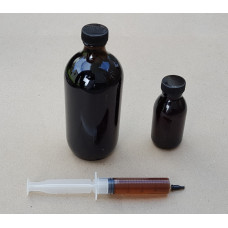This glucoamylase (a.k.a. amyloglucosidase) enzyme is
a liquid preparation, not like the powdered form more widely sold. The
advantages of the liquid form are that it is easier to measure and administer,
much easier to dissolve, and around three times more potent by weight than most
powdered products, which also makes it cheaper per unit of enzyme activity.
Glucoamylase is used to break complex, unfermentable sugars down into a form
that yeasts can readily ferment. This is good for:
·
Creating a thinnier, drier beer (less body and
sweetness) for brut or low-carb styles
·
Improve fermentation efficiency and reducing
boil foaming in spirit washes
We sell this product in sizes of:
·
20 mL capped syringe
·
100 mL bottle
·
500 mL bottle
The bottle sizes each include a 5 mL
syringe for easier measurement.
Typical usage rates are 0.75 – 2 mL per
25 litre batch of beer for brut / low-carb styles, or around 4 – 6 mL per 25 L
batch for whiskey or other grain spirit washes.
Its typical use is by adding to the
fermenter at the same time as the yeast, as it will slowly work at fermentation
temperature and pH to continuously break-down complex sugars while the yeast is
at work. It is very stable under these conditions and will typically continue
until the complex sugars are depleted. But without adequate starting enzyme,
fermentation may continue for several weeks and lead to bottle bombs (beer)
and/or yeast failing to flocculate and drop out.
In any case, it is advisable to check
that the specific gravity is stable for three days before bottling or
distilling.
This enzyme can also be used in a mash to result in a more-fermentable sugar
profile and drier beer. But why? You’ll need much more enzyme than if adding it
to the fermenter, since it will act faster but have much less time to do so..?
The reason to add it to the mash is to control just how much it dries the beer out. The enzyme will be totally killed
off during the boil, eliminating any further activity. That way you can
fine-tune the fermentability and avoid the inevitable super-dry beer that
results from the unstoppable dry enzyme during fermentation.
If adding to the mash, use these as a
guide to get the best result out of your glucoamylase:
·
It is active throughout the normal mash pH
range, but is most active at lower than normal mash pH (4.5 ideal)
·
It is active at all normal mash temperatures,
but is most active around 55 – 60°C
·
At temperatures above 50°C, it will lose
activity over time. Above 60°C, it will begin to decay at a moderate rate. At
70°C, it will decay fairly rapidly.
STORAGE:
Keep chilled at 1 – 5°C (typical
refrigerator temperature). Do not allow to freeze.
Liquid Glucoamylase 20 mL – 500 mL
- Product Code: LIGA
- Availability: In Stock
-
$6.50
- Ex Tax: $5.65
.png)
